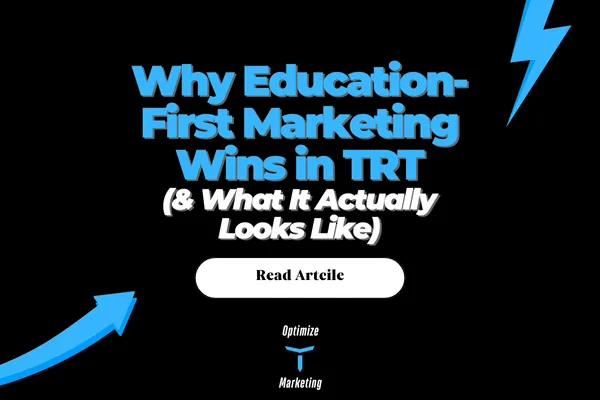
Why Education-First Marketing Wins in TRT (and What It Actually Looks Like)
Why Education-First Marketing Wins in TRT (and What It Actually Looks Like)
Most men aren’t searching for “TRT clinics near me.”
They’re Googling:
“Why am I always tired?”
“How to fix low motivation as I get older”
“How to increase testosterone naturally”
And that’s exactly why education-first marketing works so well for testosterone clinics.
If your content speaks to what they’re feeling, not just what you’re selling, you’ll earn attention before they ever think about competitors — or even realize TRT might be the solution.
Let’s break down how this works (with examples) so you can implement the strategy yourself.
The Problem with Traditional Advertising in TRT
Most ad campaigns fail because they focus on the wrong thing:
“Testosterone replacement therapy now available!”
“Comprehensive men’s health plans – call today!”
“$99 consults – limited spots!”
These may work in reactive markets like urgent care or med spas. But TRT is different — it’s not an impulse decision. It requires:
Education
Trust
A moment of recognition where the patient says, “this is me”
This is where education-first content thrives.
What “Education-First” Actually Means
Education-first marketing doesn’t mean giving away medical advice.
It means creating content that helps your audience self-identify with the problem you solve.
If he doesn’t yet know what “low T” means, your job is to meet him where he is.
Here are examples of effective, education-first angles:
“Tired all the time? It might not just be stress.”
“Losing muscle, gaining weight, and low drive? It could be your hormones.”
“3 early signs your testosterone might be low (and what to do next).”
When paired with strong visuals or video, this messaging builds curiosity and lowers resistance — because it’s helpful, not salesy.
Symptom-First Content = Trust + Leads
You’re not just educating for education’s sake. You’re moving them through the funnel by making their experience feel understood.
This kind of content builds:
Relevance: “That’s exactly how I feel.”
Trust: “They seem to really understand this.”
Urgency: “I’ve been dealing with this for a while — maybe it’s time.”
Once that mental shift happens, the leap to a consult is smaller — and your ad, page, or nurture message doesn’t have to do all the heavy lifting.
Where to Use This Content
If you’re just getting started, focus on the platforms that create high visibility and low resistance:
Meta Ads (Facebook/Instagram): Use symptom-first hooks in short-form video or UGC
Instagram Reels: Create quick tips, symptom breakdowns, or myth-busting clips
Automated Email/SMS: Nurture leads who clicked but didn’t convert
Organic Social Posts: Educate and stay top-of-mind for future bookings
This approach also works during the patient onboarding journey — reinforcing trust every step of the way.
Final Takeaway: Teach First, Convert Second
If your clinic wants sustainable growth, stop leading with “TRT” and start speaking to how your future patients feel:
What symptoms they live with
Why it’s happening
What they can do about it
That’s how you capture attention, build trust, and fill your schedule — without sounding like every other clinic.
Want content ideas tailored to your city or brand?
Let’s map out a strategy that matches your clinic’s goals. Book a call